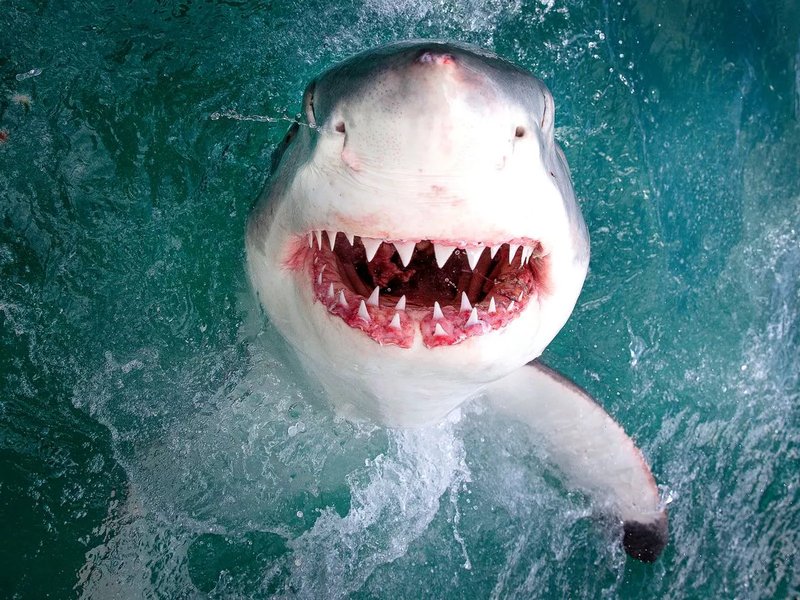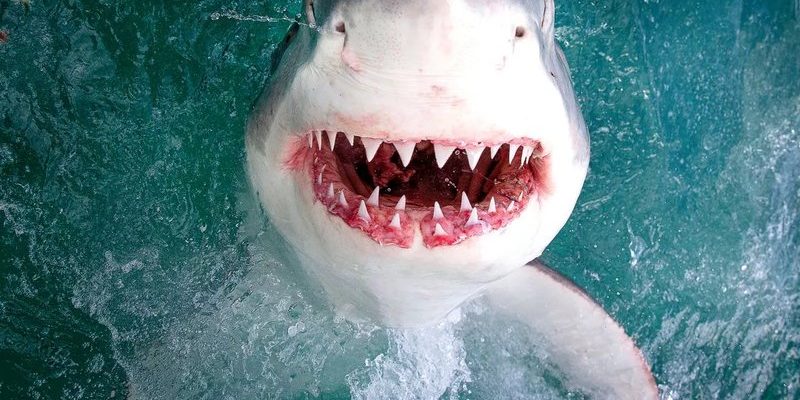
Great whites are often portrayed as mindless killers, but they’re complex creatures with unique traits. From their incredible senses to their surprising social behavior, these sharks are captivating. Learning about them not only satisfies our curiosity but also helps us appreciate the role they play in our oceans. So, let’s explore ten cool facts about these majestic sharks that are sure to change the way you see them.
1. They Can Detect a Single Drop of Blood
Think about standing on the shore, your feet in the water, with the waves rolling around you. Now imagine that a great white shark is swimming just beyond the surf. What makes these sharks such effective hunters? One of their most impressive skills is their ability to detect even the faintest trace of blood in the water.
Great whites have highly sensitive receptors called ampullae of Lorenzini. These tiny pores, located on their snouts, can sense electrical fields created by other marine animals. This ability allows them to pick up on signals from prey, even from miles away. So, if a fish happens to get a nasty cut, the great white is already on its way! It’s almost like having a built-in radar system for finding food.
2. They’re Not the Aggressive Monsters You Think
You might be surprised to learn that, despite their reputation, great white sharks are not the mindless monsters that Hollywood often depicts. In fact, attacks on humans are exceedingly rare. While the media tends to sensationalize shark incidents, most encounters are cases of mistaken identity.
Imagine a shark mistaking a surfer for a seal—its favorite meal. To a shark, the shape of a person on a surfboard could resemble that of its natural prey. More often than not, these bites are exploratory and not intended to harm. In reality, humans aren’t a part of their diet at all. So, if you’re worried about a shark attack next time you hit the beach, just remember that great whites are more interested in seal sandwiches than human snacks!
3. They Can Swim Up to 35 Miles Per Hour
If you’ve ever seen a great white breach the water, you know just how powerful they are. With bursts of speed reaching up to 35 miles per hour, these sharks are built for the chase. Picture a sports car zooming down an empty highway—that’s how fast they can move when they need to.
This speed is crucial for catching their prey. Great whites often rely on their incredible agility to surprise seals and fish. They can launch themselves out of the water in spectacular leaps, which not only looks impressive but also helps them catch fast-moving meals. So, yes, they’re swift swimmers, but they also have the element of surprise on their side!
4. They Have a Unique Hunting Technique
Ever seen an action movie where the hero sets a trap for the villain? Great whites have a similar approach to hunting! Instead of grabbing their prey immediately, they often engage in a tactic called spy hopping. This means they’ll raise their heads above the water to take a look around and identify their target.
Once they’ve zeroed in on a seal, they use their incredible speed and strength to launch a surprise attack. The way they approach their prey adds an element of cunning to their hunting style, making them not just strong, but smart as well. It’s a carefully calculated strategy, and it works well for them!
5. Great White Sharks Can Live for Over 70 Years
When you think of the lifespan of a shark, you might assume it’s on the shorter side, but great whites have a surprisingly long life. They can live over 70 years, and some might even reach their 80s!
Their lengthy lifespan gives them plenty of time to grow to impressive sizes. Females tend to be larger than males, reaching lengths up to 20 feet or more. This long life also means they accumulate a lot of knowledge about their environment, helping them adapt their hunting strategies over the years. Just think of all the fascinating stories they could tell if they could talk!
6. They Have a Complex Social Structure
You might picture great white sharks as solitary creatures, roaming the ocean alone. But here’s a surprising twist: they actually have a complex social structure! Young sharks often form groups, where they socialize and learn from one another.
These social interactions can be crucial for their development. Young sharks learn important survival skills, like how to hunt and navigate their environment. You can think of it as a school for sharks, where they bond and grow together. In a way, they’re much more than just ruthless predators; they’re social beings trying to make sense of the big ocean.
7. They Have a Specialized Diet
Great white sharks are often thought of as indiscriminate eaters, but they actually have a pretty specialized diet. While they love to feast on seals, they also enjoy a variety of other seafood. This includes fish, rays, and sometimes even whale carcasses.
Here’s a fun fact: when they hunt larger prey, like seals, they sometimes bite and then circle back to let their prey weaken from the injury before going in for the kill. This tactic allows them to consume big meals without using too much energy. So, they’re strategic eaters, always thinking about the best way to secure their dinner!
8. They Can Regenerate Their Teeth
Have you ever lost a tooth as a kid? That can be a pretty big deal! But for great whites, losing teeth is just a part of life. These sharks are famous for their regenerative teeth. They can lose thousands of teeth over their lifetimes and still have a full set ready to go.
When a tooth falls out, a new one moves up from the back to take its place. This unique feature ensures that they’re always prepared for hunting, even if a tooth gets knocked loose during a fight or while consuming tough prey. It’s nature’s way of keeping these predators at the top of their game!
9. They Can Travel Long Distances
Imagine going on a spontaneous road trip with no set destination—that’s a bit like what great white sharks do in the ocean! They are known for migrating long distances, often covering thousands of miles in search of food or mates.
Some data suggests that they can travel as much as 2,500 miles in a single journey. This long-range traveling is essential for maintaining their populations and ensuring their survival. It also reveals their adaptability to changing ocean conditions and shifting food sources. So, if you ever see a documentary showcasing their epic journeys, you’re witnessing how adaptable and resilient these creatures are!
10. They Play a Vital Role in the Ecosystem
Finally, let’s talk about the important role great white sharks play in maintaining the health of the ocean. They’re often referred to as keystone species because their presence helps keep other populations in check. By preying on sick or weak animals, they help ensure that fish populations remain strong and healthy.
Keeping balance in nature is critical, and great whites do just that. If their numbers decline, the entire marine ecosystem can suffer as a result. By protecting and conserving great whites, we help safeguard the health of our oceans for generations to come.
As we wrap up our journey through the world of great white sharks, it’s clear that there’s much more than meets the eye. From their incredible senses to their long-distance travels, these sharks are truly fascinating creatures. Understanding them is key to appreciating their role in the marine world—and perhaps even feeling a little less fear when we think of these ocean giants. So the next time you hear about a great white shark, remember that there’s so much more to discover beneath the surface!

